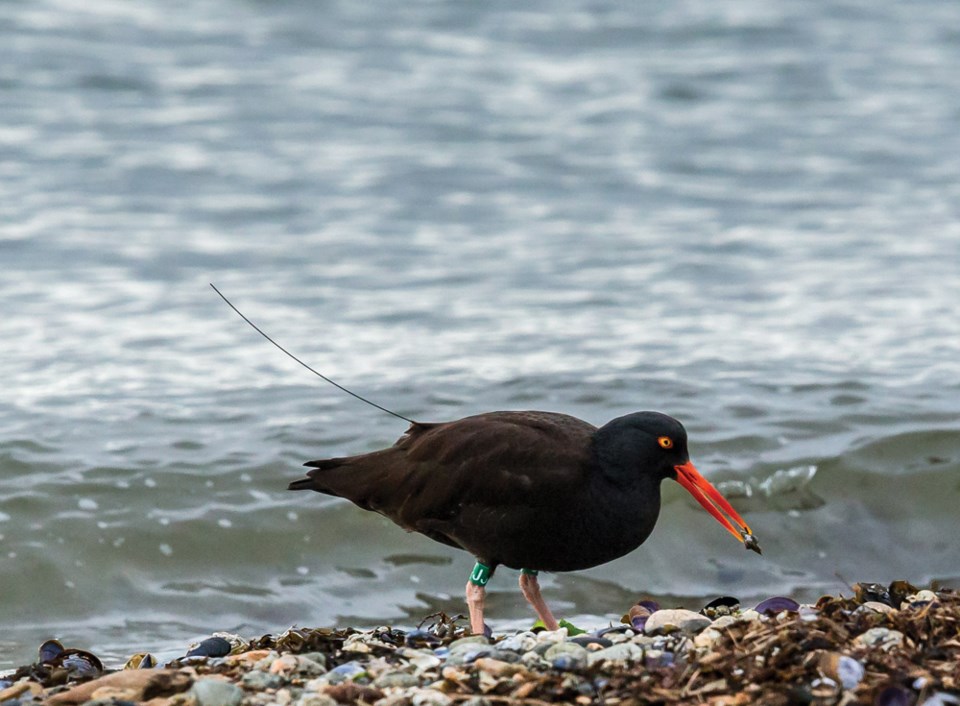Black oystercatchers may be conspicuous creatures on the shorelines of the Pacific Coast, but their movements are mysterious.
That mystery and their prevalence have prompted Simon Fraser University researchers to outfit a few with solar-powered satellite tags and “backpacks” to track their traverses.
“The year-round movements of black oystercatchers are unknown currently,” said master’s student Lena Ware, who is leading the research project with her supervisor David Green through SFU’s Centre for Wildlife Ecology. “The tags will give us really high quality location data for two to three years.”
The duo are spending the month travelling to sites on the Sunshine Coast, at Pacific Rim National Park on Vancouver Island and Haida Gwaii.
They spent about five days on the Sunshine Coast at Roberts Creek and Mission Point in Davis Bay, the location of choice for the biologists because of the sizable flocks, upwards of 100 birds especially in the fall, and the ease of access. “It’s hard to find a place that’s so accessible where you can just park and walk out to,” said Ware.
They catch the birds by laying down a special carpet affixed with tiny nooses, luring them with a decoy speaker that plays birdcalls. Once caught, they affix two green identifier bands to the oystercatchers’ legs. They’re also outfitted with an antenna attached to a tiny box with solar panels, “kind of like a backpack,” explained Ware. Bird researchers commonly use the harnesses.
Ware and Green were able to tag four birds on the Coast and have since been tracking their movements online. One has flown to Gambier Island, another made its way up Salmon Inlet. “They are all moving along and doing great,” said Ware.
Black oystercatchers had long been considered homebodies, living in one area their entire lives, but 10 years ago a study showed that in fact they are highly migratory. “Some of the birds we tagged in the winter we don’t know where they are going to breed, some of them could potentially book it up north a couple thousand kilometres,” said Ware.
They are, however, the only bird species that spend the entire year in intertidal ecosystems and which breed and winter in the exact same place each year, making them an ideal “intertidal indicator species” for coastal health. “If one year there’s no oystercatchers, that’s an indication about specifically that area,” said Ware.
That understanding could also be used by cleanup crews when oil spills happen – giving emergency responders knowledge of what areas to clean first to save wildlife. Ware said they expect to learn more, but that will happen once the information from the 20 birds they hope to tag starts pouring in. “It’s incredible data, there’s so much we can do with it.”
The SFU lab collaborates with Environment and Climate Change Canada with funding for the project coming from the federal government’s $1.5-billion Ocean Protection Plan.
On Wednesday, Ware and Green were on Long Beach in Tofino and have partnered with Parks Canada and the Raincoast Education Society on Vancouver Island. After that they will head to Haida Gwaii, where they will work with Council of the Haida Nation, provincial Ministry of Forests and Resources, and the Laskeek Bay Conservation Society.
Ware, who formerly lived in Madeira Park, got her start in ecology in 2011 at the Iris Griffith Field Studies and Interpretative Centre, where she had her very first “nature job.”



